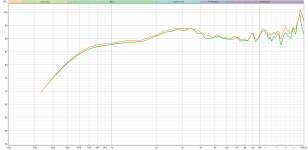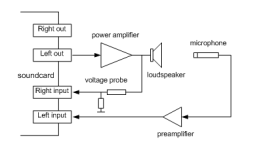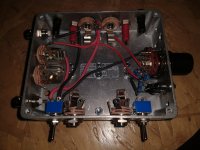I'm switching, because I don't know what to do with the above.
I also don't really know how to make use of my anechoic measurements with both drivers, yet I just did something. I combined my high quality waveguide measurements with some low quality woofer measurements in VituixCAD and came up with this:
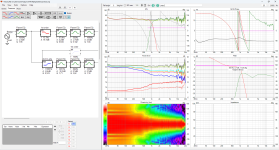
I typed the settings in my minidsp and.... measurements with REW showed a far from flat FR. I changed some filters in the minidsp and that helped a bit, but I didn't pay too much attention to it as I was most interested in the DI for the complete speaker.
I measured only 90 deg and that resulted in this (gate 4ms):
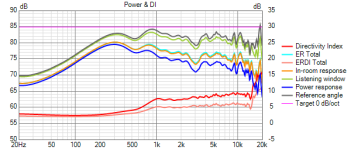
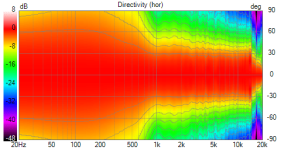
I guess I should try to get the knee less pronounced.
What whould be the correct way to approach this? What should I measure? What about z offset for instance? What about the vertical offset? I there some documentation online?
I also don't really know how to make use of my anechoic measurements with both drivers, yet I just did something. I combined my high quality waveguide measurements with some low quality woofer measurements in VituixCAD and came up with this:

I typed the settings in my minidsp and.... measurements with REW showed a far from flat FR. I changed some filters in the minidsp and that helped a bit, but I didn't pay too much attention to it as I was most interested in the DI for the complete speaker.
I measured only 90 deg and that resulted in this (gate 4ms):


I guess I should try to get the knee less pronounced.
What whould be the correct way to approach this? What should I measure? What about z offset for instance? What about the vertical offset? I there some documentation online?
The Vituix help file has a walk through of the options for a basic speaker design.What whould be the correct way to approach this? What should I measure? What about z offset for instance? What about the vertical offset? I there some documentation online?
As you are using a USB mic, timing measurements of separate drivers is not straightforward and can lead to inaccuracies.
Here are a couple of articles that might help
https://www.htguide.com/forum/artic...nimum-phase-and-accurate-crossover-simulation
https://www.htguide.com/forum/articles/do-it-yourself-diy/927364-single-vs-dual-channel-measurements
If you measure both drivers from the same point like a completed speaker. All the phase offsets are already baked into the measurement and the drivers can be at 0 for x,y and z.
The Vituix recommendation is to measure each driver separately directly on it's axis and to use the Y value to represent vertical height between the drivers. This results in a better prediction of the 3D radiation. 0 is listening height, often the tweeter but not always. The measurement preparations files have a drawing that shows how the coordinates relate to a physical speaker.
If you have an USB sound card at hand, I'd say: get a Behringer ECM8000. Make a correction file yourself if necessary. That way and with dual channel measurement mode your timing issue has gone.
Is there any particular reason you are not switching to cardioid mid? Or did you intend to use the low end?
Is there any particular reason you are not switching to cardioid mid? Or did you intend to use the low end?
Ignorance... I thought the Umik-1 was the measurement mic to use.Is there any particular reason you are not switching to cardioid mid?
I have a Behringer U-PHORIA UMC204HD I used for my amplifier testing and still use for impedance measurements.
I do have an SM57 lying around from the days I wanted to be a guitar hero 😳. Do you suggest cardioid to limit detection of reflections?
I guess the mike to use would be branded Bruel&Kjaer, Microtech Gefell or Gras. But since you own a microphone with a correction file that is reasonably accurate, you can use anything lying around just to get the phase around 1-2kHz right. The problem with USB mikes is (as I understand it) that these have to estimate the delay from the impulse response, by taking some level (say 80% of the max level) on the rising flank of the impulse response as reference. Trouble is that a low passed system such as a woofer has a much slower rise time on that response, so the software always will assume a delay that is longer than e.g. with a tweeter and thus will be more off.
Second problem of USB mikes is that the AD and the DA are not in sync. But that only would lead to phase errors at high frequencies and normally that is of no interest.
As fluid said, there are workarounds. But If you are serious in developing loudspeakers, dual channel measurement with a reference time base is a no-brainer.
As for cardioid: you probably read about the Dutch&Dutch history here and/or other cardioid developments. Apart from big horns these are the way to get the directivity up in low to mid frequencies. But they need to be combined with a LF channel.
Second problem of USB mikes is that the AD and the DA are not in sync. But that only would lead to phase errors at high frequencies and normally that is of no interest.
As fluid said, there are workarounds. But If you are serious in developing loudspeakers, dual channel measurement with a reference time base is a no-brainer.
As for cardioid: you probably read about the Dutch&Dutch history here and/or other cardioid developments. Apart from big horns these are the way to get the directivity up in low to mid frequencies. But they need to be combined with a LF channel.
I thought you made a typo and meant 'mic' iso 'mid', but now I'm not that sure anymore.Is there any particular reason you are not switching to cardioid mid? Or did you intend to use the low end?
I don't understand what you are saying and I haven't read the Dutch&Dutch thing.
Edit: or do you mean the round top thing with and opening behind the speaker in the Ath thread?
Last edited:
You have some reading to do 😉, start here, cardioid that lead to the D&D8C. But let's not forget the works of Kimmo Saunisto and others (should I mention the Kii-loudspeaker?)
All in all these boil down to directivity control below 500Hz in a fairly normal speaker. It was a 'craze' then and it should be now. Like an alternative to big (ME) horns.
All in all these boil down to directivity control below 500Hz in a fairly normal speaker. It was a 'craze' then and it should be now. Like an alternative to big (ME) horns.
Just for inspiration:
One more sleek looking (to my eyes) commercial full-range cardioid in the works.. 😀
https://audiosciencereview.com/foru...yes-m3-formerly-known-as-m2.14656/post-954783
https://ggntkt.de/en/model-m2-kommt-als-model-m3-status-quo-teil-3/
One more sleek looking (to my eyes) commercial full-range cardioid in the works.. 😀
https://audiosciencereview.com/foru...yes-m3-formerly-known-as-m2.14656/post-954783
https://ggntkt.de/en/model-m2-kommt-als-model-m3-status-quo-teil-3/
I'll probably read some, but for now I stick to the current solution. I try to bring that to an end. Who knows what the next journey will be.
While you can in theory calibrate any microphone to another (calibration against a known traceable reference is the main way anything is calibrated) an SM57 or other mic that is not an omnidirectional measurement style mic won't have the same pattern and is likely to throw another lot of confusions into the mix.
This is the mic I use, it is pretty cheap comes with an individual calibration file.
https://www.thomann.de/gb/sonarworks_soundid_ref_measurement_micro.htm
I could buy a much more expensive "better" mic and I am tempted to all the time, so far the analytical side of my brain has won.
You could save some money and buy a cheaper measurement mic and match it to your UMIK like this
https://johnr.hifizine.com/2012/12/diy-mic-calibration/
I have done the 90 degree version of that and it works.
This is the mic I use, it is pretty cheap comes with an individual calibration file.
https://www.thomann.de/gb/sonarworks_soundid_ref_measurement_micro.htm
I could buy a much more expensive "better" mic and I am tempted to all the time, so far the analytical side of my brain has won.
You could save some money and buy a cheaper measurement mic and match it to your UMIK like this
https://johnr.hifizine.com/2012/12/diy-mic-calibration/
I have done the 90 degree version of that and it works.
Is the biggest pro of the UMIK-1 then that it is a USB mic that doesn't need an audio interface?
While I certainly don't need another lot of confusion, could you explain what these would be?
While I certainly don't need another lot of confusion, could you explain what these would be?
The UMIK is self contained, calibrated and pretty cheap. It works well for in room measurements and other's where timing fidelity doesn't matter.
Whether a USB mic's timing problem matters depends on how you intend to measure and design your speaker. A good enough analogue mic and good enough interface like your Behringer is more money but it is absolutely the right choice if you can only have one. You never regret buying the right tool for the job even if it costs more, but I still find myself regretting buying something that was cheaper, that I hoped would be good enough only to find out it never is 🙂
Whether a USB mic's timing problem matters depends on how you intend to measure and design your speaker. A good enough analogue mic and good enough interface like your Behringer is more money but it is absolutely the right choice if you can only have one. You never regret buying the right tool for the job even if it costs more, but I still find myself regretting buying something that was cheaper, that I hoped would be good enough only to find out it never is 🙂
I did some measurements with the SM57 in a full dual channel measurement.
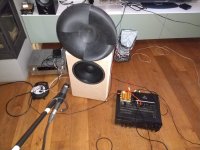
As you can see, I didn't take any care to remove reflections. I just wanted to test the setup and see if perhaps the weird (pre-)ringing I had had disappeared.
The result are very repeatable and I haven't had any ringing in ~30 measurements, way less than before. The measurements are also very clean. I think the cardioid sensitivity is helping to suppress measuring of reflections coming from other directions than the direct sound.
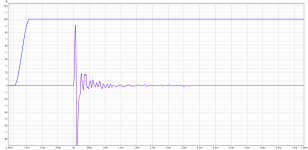
And here is a comparison between the measurement setup above and a barn measurement at 2.6m from the ground without a window applied:
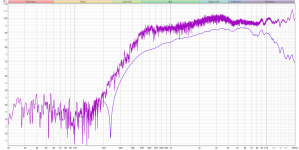
Of course the SM57 doesn't have a flat response. I could calibrate it against the UMIK-1.
At this moment I see more benefit in the cardioid mic than negatives. Am I missing something?

As you can see, I didn't take any care to remove reflections. I just wanted to test the setup and see if perhaps the weird (pre-)ringing I had had disappeared.
The result are very repeatable and I haven't had any ringing in ~30 measurements, way less than before. The measurements are also very clean. I think the cardioid sensitivity is helping to suppress measuring of reflections coming from other directions than the direct sound.

And here is a comparison between the measurement setup above and a barn measurement at 2.6m from the ground without a window applied:

Of course the SM57 doesn't have a flat response. I could calibrate it against the UMIK-1.
At this moment I see more benefit in the cardioid mic than negatives. Am I missing something?
The frequency responses are completely different, so without some form of calibration to a known reference, which if either is accurate?At this moment I see more benefit in the cardioid mic than negatives. Am I missing something?
The earliest reflection should still be the same in most cases (floor/ceiling) so when windowed to remove that the directivity advantage of a directional microphone is gone.
The barn measurement is done with a calibrated UMIK-1, so that can be the reference. I guess I might also be able to get a calibrated cardioid (or even more directional) mic. I hope FR and directivity are 'ortogonal'.The frequency responses are completely different, so without some form of calibration to a known reference, which if either is accurate?
Yes, ok, but can't we exploit that directivity some more? What about pointing the back of the microphone to the floor? That is the first reflection. If you can remove that, you've made your room virtually bigger. Or what about two measurement with the mic at different angles. Like this, dash is mic: speaker \ vs. speaker /. Subtracting those measurements will theoretically result in only reflections, which you can then subtract from a measurement (after some scaling). Or what about a bidirectional mic? Or a combination of measurements with both mic's?The earliest reflection should still be the same in most cases (floor/ceiling) so when windowed to remove that the directivity advantage of a directional microphone is gone.
Sure but then you need to suspend your speaker from the ceiling 🙂Yes, ok, but can't we exploit that directivity some more? What about pointing the back of the microphone to the floor? That is the first reflection. If you can remove that, you've made your room virtually bigger.
If there is a simple way to reliably allow the removal of reflections in measurements I have not seen it. Beamforming works but it needs too many points to make it simple. Maybe we need to make an automated slide to go with the turntable 😉Or what about two measurement with the mic at different angles. Like this, dash is mic: speaker \ vs. speaker /. Subtracting those measurements will theoretically result in only reflections, which you can then subtract from a measurement (after some scaling). Or what about a bidirectional mic? Or a combination of measurements with both mic's?
Cardioids have (just like cardioid speakers) a natural high pass, unlike omni (closed back) capsule microphones. And the directivity is frequency-dependent. So while useable for frequencies 100-150 Hz and up, low frequency measurements aren’t very exact.
The Klippel NFS applies some sort of pressure gradient measurement by mathematically comparing measurements at different distances from the speaker. And arrays like the MiniDSP Umik X-4 could offer such options too, I guess.
The Klippel NFS applies some sort of pressure gradient measurement by mathematically comparing measurements at different distances from the speaker. And arrays like the MiniDSP Umik X-4 could offer such options too, I guess.
Last edited:
- Home
- Loudspeakers
- Multi-Way
- Efficient 2-way
